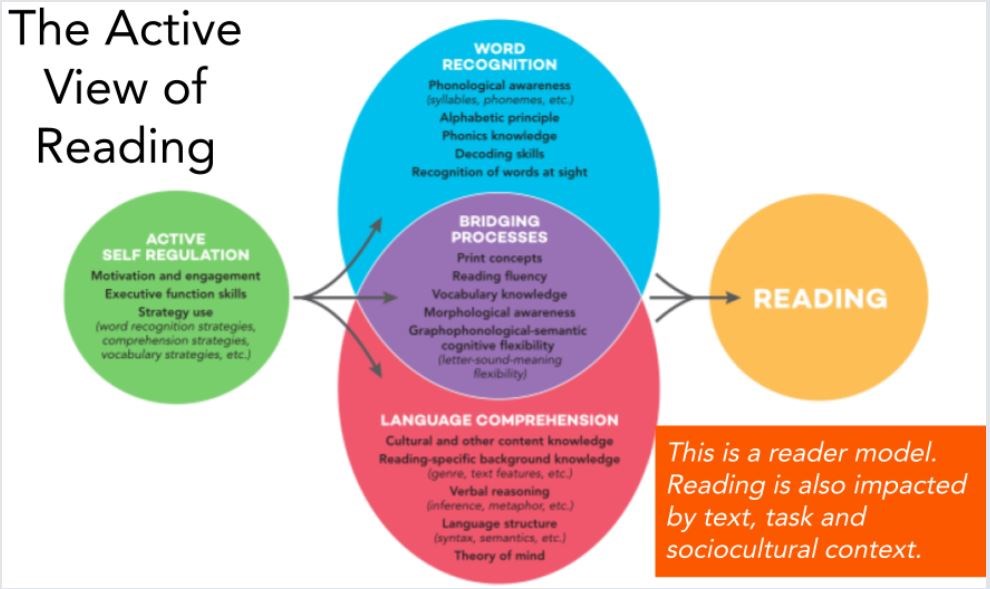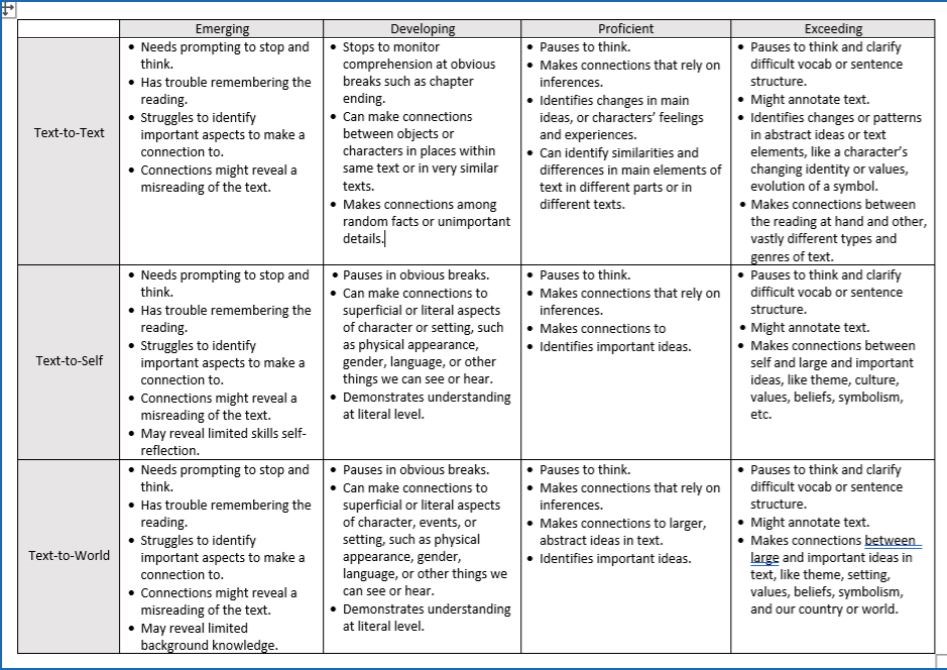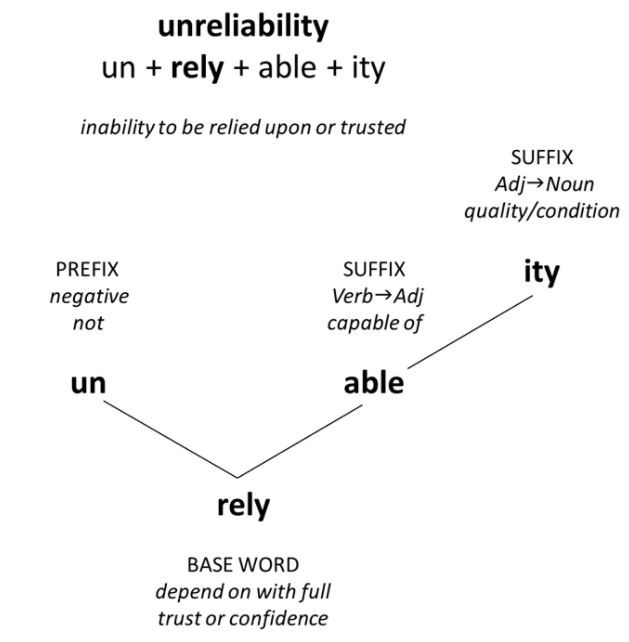Teaching Reading Comprehension
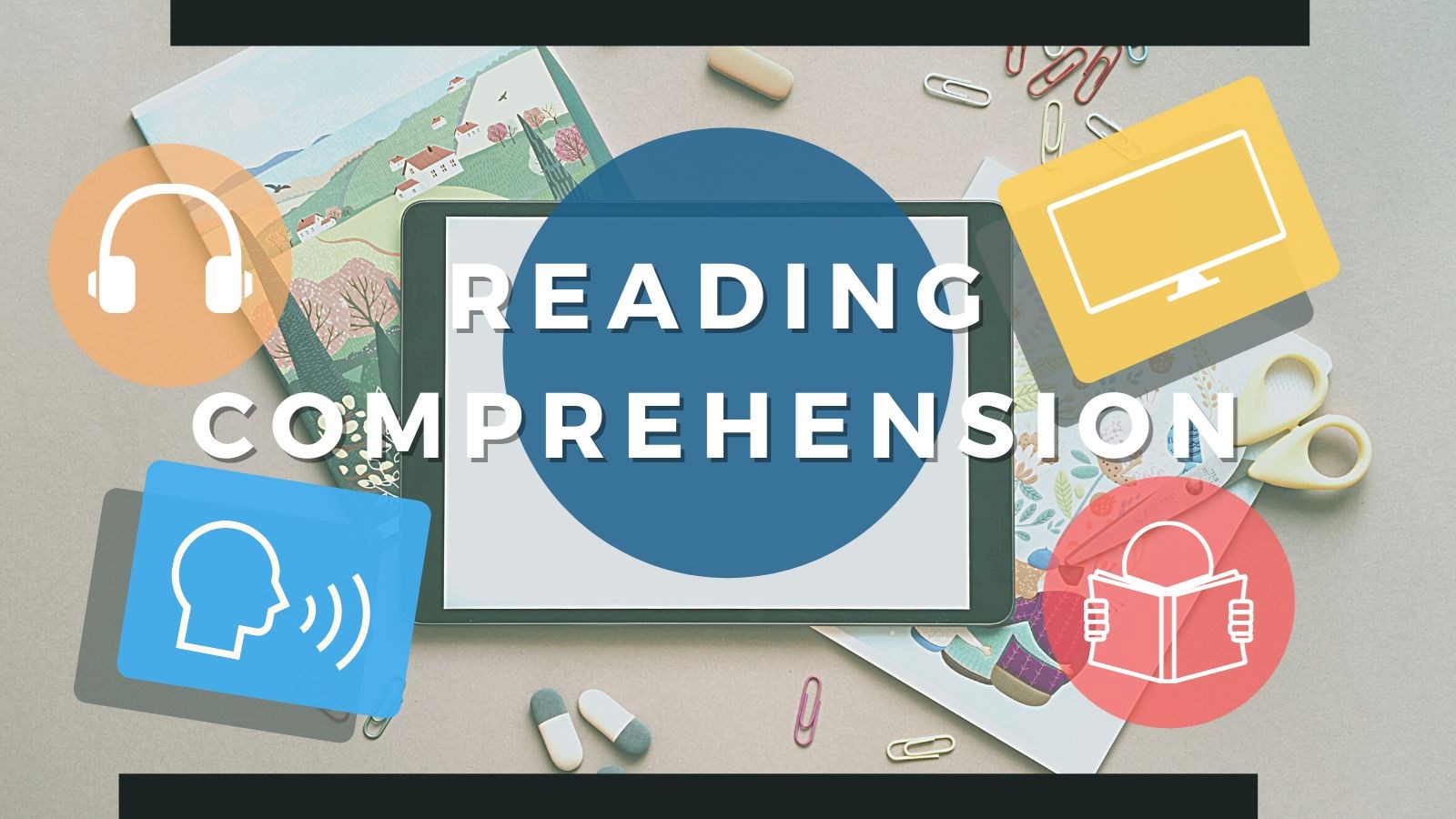
The whole point of strategy instruction is for students to understand text - to find certain types of information, access and interact with the ideas put forward - a means to rewarding ends. Research has shown that, when students monitor their own comprehension and know when and how to use a strategy, their reading comprehension improves. In contrast, when students practice using a strategy (ex. do a "connections" worksheet) as an ends in itself, they improve in isolated strategy use but not in reading comprehension. ~Pearson
Active Self-Regulation
Introducing Reading Comprehension & Strategy Use
- Make a t-chart with the titles, Decoding and Comprehension. Put an unfamiliar, polysyllabic word, such as, "pneumonoultrasilicovolcanoconiosis" or T Chart with Titles "antidistestablishmentarianism" on the board.
- Ask students to read the word. Ask the students how they figured out how to say it. Sounding out by letter, syllable, or familiar part will be common strategies.
- Teach students that this is decoding. Have them write the strategies on the t-chart.
- Next, ask students what the word means. Invariably, some students will start to identify familiar parts of the word. Tell them that this is one strategy we can use to construct comprehension and write it in the respective column of the t-chart.
- Show students the Reading Process System graphic in the Attachments, called, "In the Head of the Reader" so they can see how active they must be to actually make
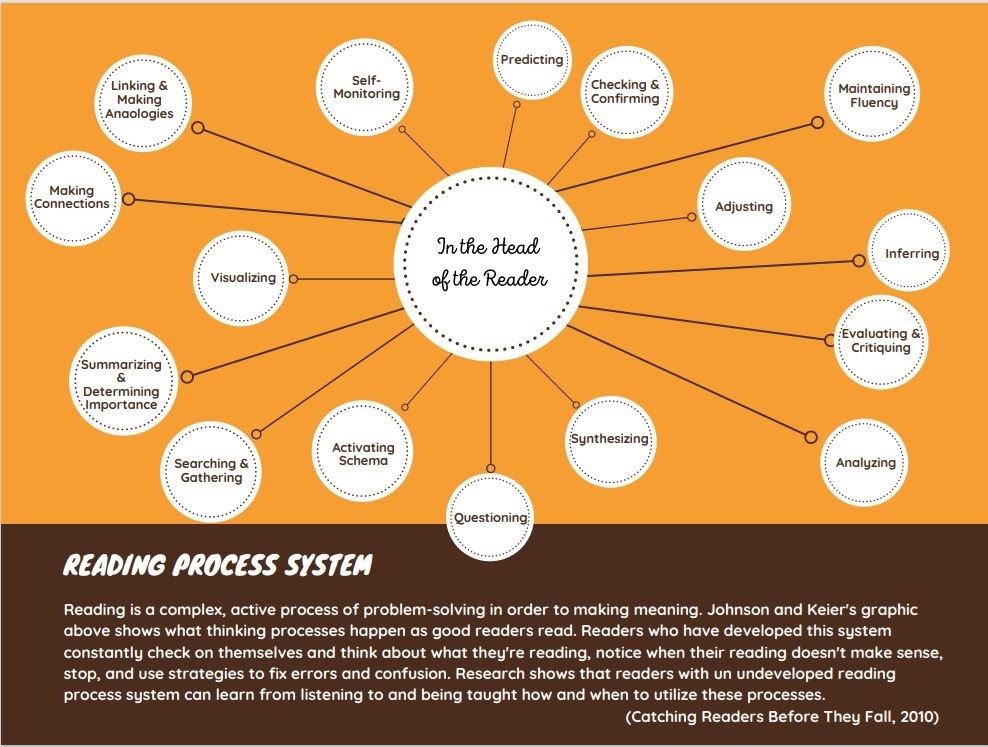 sense of what they read.
sense of what they read. - Give students something a bit tough to read. Have them self-monitor, identifying parts they do not understand. Students can watch for patterns in their comprehension, set goals, and track their progress.
- Next, have students keep track of what they do to make sense of the text.
- Debrief #7 as a class and put student answers on chart paper to build a "Reading Strategies List" that gets posted and added to as the course progresses.
Reading Comprehension Strategies
- Activating Schema: Also called "activate prior knowledge" or "mental set." This involves identifying the big ideas, themes, topics, beliefs, values, or shared human experiences - whichever you will focus on - explored in a text (or film), and without spoiling it, introducing that element to students to elicit their pre-reading emotions, beliefs, or experiences surrounding it. Activating schema allows it to be more easily changed or added to. Example: check out The Black Hole Pre-Viewing Survey.pdf for the short film, The Black Hole.
Inferring: Good readers "read between the lines" by using background knowledge to make sense of text clues. Inferences can be predictions or conclusions, but as a strategy that increases comprehension, Literacy Guru, Tim Shanahan has this to say:
"treating inferencing not as a skill but as a strategy for intentionally making sense of text. Students how take specific steps to consciously identify motivations, causes and linguistic connections are likely to comprehend better. Teaching them to infer just for inferencing sake are not."
- Predicting: We use our background knowledge on a subject to make predictions. Little background knowledge = weak prediction. Hearing students' predictions allows us to formatively assess where they are starting and what gaps we might need to fill in before teaching. Making predictions can also help to activate our thoughts and emotions, creating engagement. But Literacy Guru, Tim Shanahan also argues that making predictions is not important to gaining meaning, let alone in and of itself. In short, he warns us not to evaluate predicting ability, but to use it to motivate students through text, and to provide practice in finding certain information: motivation, cause and effect, and linguistic connections (following pronouns or concepts across a text).
Example: Have students predict what a character will do when faced with an ethical dilemma, or how Oxygen might become an ion and how it will behave when it does.
- Comprehension Monitoring: Teach students to identify parts of the text they do and do not understand by annotating and traffic lighting.
- Summarizing: Teach students to identify main ideas and details and determine what's important.
- Questioning: Teaching students to ask questions can deepen their own learning of that of their peers, especially if we teach them how to ask questions at different levels.
- Making Connections: Making Text-to-Self, Text-to-Text, and Text-to-World help students to assimilate new concepts into their current schema. When we learn something new, we attach it to our prior knowledge of the world. To encourage high quality connections, first co-construct criteria with students for Emerging, Developing, Proficient, and Extending Connections.
- Visualizing: Sample Lesson
- Searching & Gathering: Readers search and gather in order to make inferences, confirmations, generalizations, evaluations and conclusions. When we search and gather, we look for patterns that amount to a bigger picture. Example: Setting and Mood.pdf
- Linking/Making Analogies
- Adjusting
- Evaluating
- Analyzing
- Synthesizing
Language Comprehension
Reading-Specific Background Knowledge
- The Text Structure Strategy teaches students how to predict, find, and summarize main ideas and details of different types of texts, like narrative, expository, or persuasive.
(See attachments: "4Cs-concept or Main Idea" slides and the "Text Structure Signal Words")
Verbal Reasoning
- Making inferences
- Metaphor
Language Structure
- Use the handouts on this Grammar Site as examples of how to work on sentence structure. Use this one for explanations. Teach the concepts below, in order, one at a time, using the "I do, we do, you do" method. Use student work, rather than the worksheets, to teach the concepts so the learning is relevant, local, and immediate.
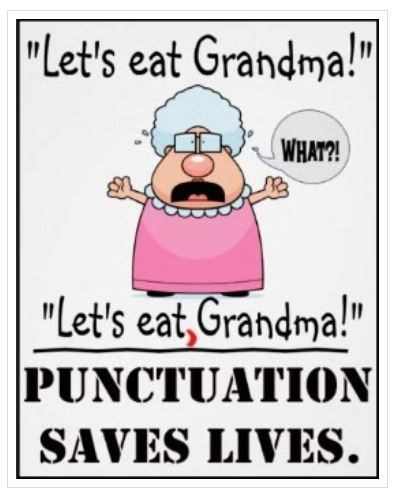
- The 8 Parts of Speech
- Complete subjects and predicates
- Simple subjects and predicates
- Direct and indirect objects
- Independent and subordinate clauses
- Sentence fragments and run-ons / comma splice errors
- Sentence type and purpose
- Simple, compound and complex sentences: Identify them & write them
- Sentence combining
Bridging Processes
Reading Fluency 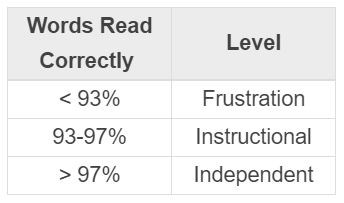 Fluency Measure
Fluency Measure
- Fluency is the ability to read with automaticity - with speed, accuracy, and proper expression. Fluency is essential for comprehension; without it, reading is labored and interrupted. But fluency does not guarantee that a student comprehends.
- Fluency Intervention Sequence:
- Fluency Acquisition: When students have adequate phonics decoding skills but struggle to apply them to reading. Task: Supported Cloze Reading in Dyads and Triads.
- Fluency Transitional 1: When students have adequate phonics decoding skills but are challenged with reading connected text (multiple sentences related to each other) fluently. Task: Repeated reading of the same passage, such as the "Six Minute Solution." More on Repeated Reading and data tracking (without comprehension)
- Fluency Transitional 2: When students have adequate phonics decoding skills but are challenged with reading connected text with adequate fluency and comprehension. Task: Repeated Reading with Comprehension
- Fluency Transitional 3: When students have adequate phonics decoding skills but are challenged with reading text with adequate fluency and comprehension. Task: Partner Reading with Paragraph Shrinking
- Websites with free, levelled reading passages:
Vocabulary
- Edutopia's "Doing it Differently: Tips for Teaching Vocabulary" - how to select, rank, and teach vocabulary.
- We are Teachers' "15 Meaningful Vocabulary Activities that Work in Person or Online" - ideas for visual and tactile learning.
- Fountas and Pinnell's "Ways to Increase Your Students' Vocabulary"
Morphological Awareness
- Morphology is the study of words and their parts. The smallest unit of meaning is a morpheme. Learning morphology helps students with vocabulary, comprehension, and writing or constructing meaningfully. See how the word "Unreliability" is broken into its smallest units of meaning).
Other Resources
- Introduce and model strategy use with the Think-Aloud. See the supplementary attachments on this page.
- Project Zero's (Harvard) Thinking Routine Toolbox.
- Disciplinary Literacy Teaching Toolkit (subject-specific norms for thinking, reading, writing)
- Reading Rockets is a trustworthy source of articles for professional learning and practical, ready-to-use strategies.
Useful Videos
Think-Aloud Strategy - Effective at all ages:
-
 In the head of the reader.pdf
In the head of the reader.pdf -
 thinkaloud_checklist.pdf
thinkaloud_checklist.pdf -
 Think-Aloud Planning Template.pdf
Think-Aloud Planning Template.pdf -
 Strategies for Struggling Readers_Martin&Pappas.pdf
Strategies for Struggling Readers_Martin&Pappas.pdf -
 ComprehensionMonitoring_flowchartofbehavior.pdf
ComprehensionMonitoring_flowchartofbehavior.pdf -
 ComprehensionStrategyPrompts.pdf
ComprehensionStrategyPrompts.pdf -
 Comprehension Strategy Package_Cut The Deck.pdf
Comprehension Strategy Package_Cut The Deck.pdf -
 Clarification Strategy_stopaskfixchecklist.pdf
Clarification Strategy_stopaskfixchecklist.pdf -
 Intro to Summarizing.pdf
Intro to Summarizing.pdf -
 Summarizing Strategies.pdf
Summarizing Strategies.pdf -
 Making Connections.pdf
Making Connections.pdf -
 4C's-Concept or Main Idea.pdf
4C's-Concept or Main Idea.pdf -
 Theme or Authors Main Idea.pdf
Theme or Authors Main Idea.pdf -
 Text Structure Signal Words.pdf
Text Structure Signal Words.pdf -
 Morphological-Awareness.pdf
Morphological-Awareness.pdf





